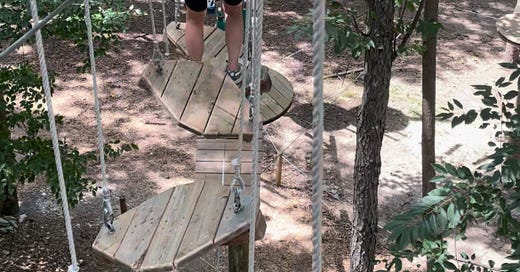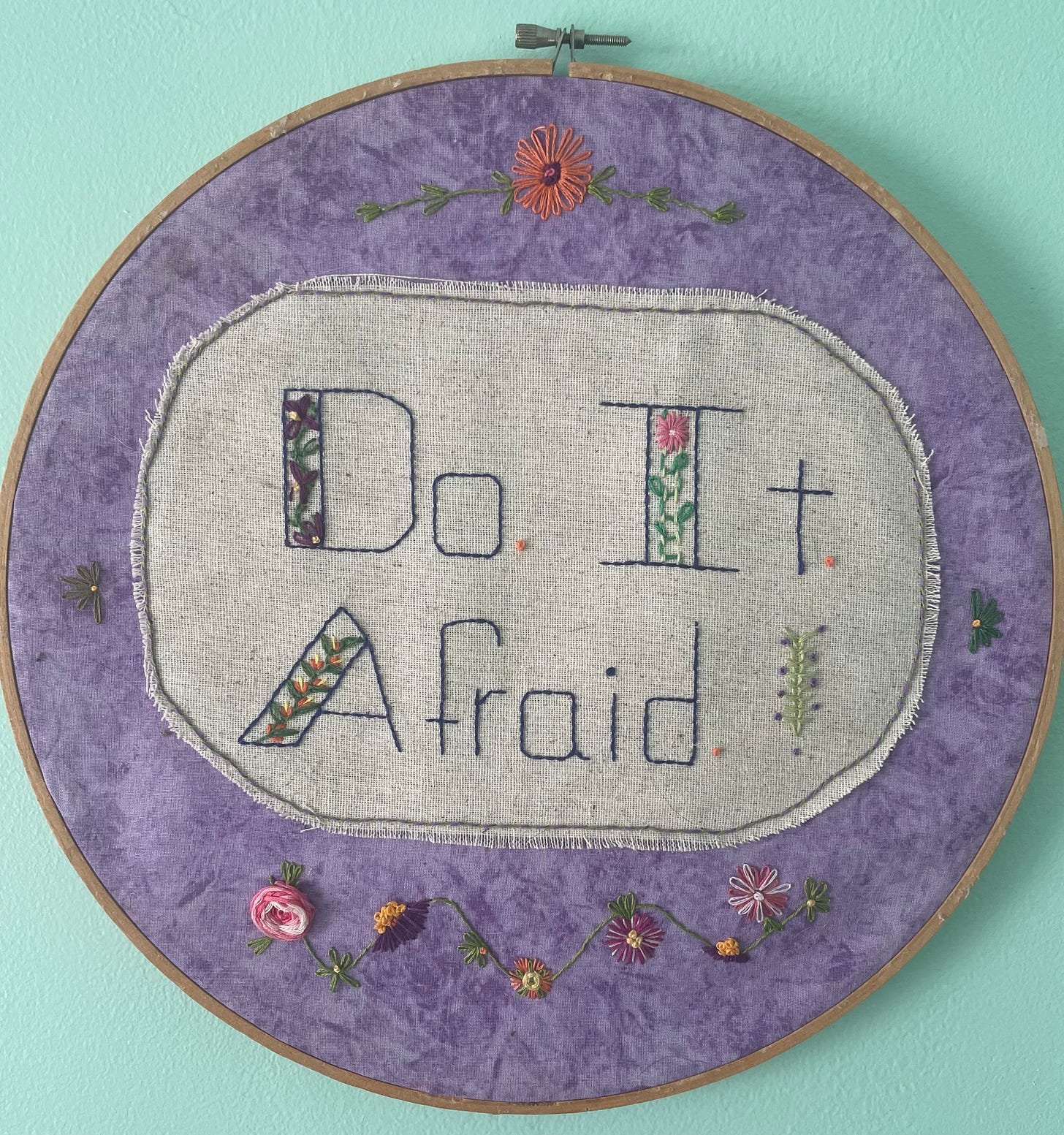Exposure Therapy: The Only Way Out, Is Through
Exposure therapy is an excellent treatment strategy for anxiety and OCD
If you are new here, welcome to Dr. Amber_Writes. I am a clinical psychologist that writes weekly about mental health. I aim to bring you evidenced-based information, with a personal touch. Check out this post to read more about why I started writing in the first place. If you want to hear from me again, subscribe any time.
A couple years ago, I took my husband on a surprise day-date to a local “aerial adventure and zipline park.” The park was in a wooded area, with a complex system of aerial obstacle courses that stretched between wooden platforms. Participants wore harnesses and were given a brief lesson on how to clip and unclip themselves from the zip lines that would stop them from plummeting to the ground.
There were numerous courses of varying difficulties, starting with ones that are suitable for children as young as seven. The most advanced courses, labeled as Double Black Diamonds, were described as “ninja warrior level”, but still only required participants to be at least 12 years old. So basically, this activity was designed for children.
This was our first visit, and despite my middle-age, I was not at the “ninja warrior” level. My anxiety began to rise as soon as I realized that I would be responsible for hooking and unhooking myself from the safety rope. Who, me? The same person who once locked her car keys in the trunk?
I sat in our 10 minute tutorial with two other families, both with children who looked no older than 6. Thoughts like, “is this even legal?” began to bounce around in my mind, causing my tension to rise.
Once we were given the go ahead, we made our way to the centralized platform where all the aerial trails began. As I progressed through the beginner trails and began tackling the more intermediate ones, I began to experience moments where my anxiety shifted from “anxious in a thrilling way” to “oh no, someone is going to have to rescue me.”
The most challenging obstacle required me to hold onto a rope and jump off a high platform, trusting that the rope would engage a mechanism that would catch and slow my descent until I met the ground. Although I was harnessed, it felt like just jumping off a cliff. Physically, I felt every sign that I was in danger- my muscles seemed to resist moving towards the platform, as if by instinct. There was no way to convince my body that this was a good idea, the only option was to jump anyway. Eventually, I did. The lady ahead of me opted to have an employee come help her down.
Anxiety and Taking the Jump
As a therapist, I work primarily with clients experiencing anxiety disorders, phobias, and OCD. A core component of anxiety treatment involves exposure to a feared stimulus on purpose, without distraction, and without any attempt to control or minimize the anxiety. It’s called Exposure and Response Prevention Therapy (ERP).
I think it feels a lot like standing on a 60 foot platform and jumping, while imaginary headlines flash before your eyes; “Local Psychologist Dies in Ziplining Catastrophe; Birthday Party Full of First-Graders Traumatized.”
Exposure therapy is challenging, but I think it gets a bad wrap. If you see a therapist that uses exposure techniques, you can expect that you will eventually be encouraged to face your fears without using safety behaviors, compulsions, and avoidance to manage your painful emotions. This may look like touching a surface that you deem “contaminated” like a public door knob, with no gloves and without washing your hands.
If you fear death, you may be given the task of visiting a cemetery or writing your own eulogy.
I frequently work with individuals with a phobia of vomit, called Emetophobia, so our sessions might include watching videos of drunk frat brothers puking their brains out.
Critics maintain that exposure therapy has the potential to be cruel or traumatic, and I do not doubt that some clients have experienced it as such. Therapeutic interventions are powerful, and when misused or done poorly, they have the potential to do real harm. This is why anxiety specialists encourage clients to see experienced clinicians with anxiety and exposure-specific training. Appropriate exposure therapy should challenge you, but always feel respectful and consensual.
How Exposure Works
When it comes to anxiety, the only way out is through. When we purposely do something that causes anxiety, two important processes can occur. First, our body has the opportunity to habituate to the uncomfortable sensations that accompany the emotion of fear. At first, the tension in your body will sky rocket. But as you allow that emotion to wash over you, you will notice that it slowly but surely fades away. Even if you do not remove yourself from the scary situation, the anxiety dissipates with time. The next time you approach that frightening scenario, it's likely that the anxiety will not peak as high, and it might even dissipate faster. This pattern continues until eventually, you are not afraid at all.
The second important thing that happens when we practice exposure, is simply learning that the feared outcome does not occur. It gives us the opportunity to challenge our expectations, which cannot happen if we never do the scary thing.
To illustrate this, I often use the example of my personal phobia of spiders. I was not born frightened of spiders, but I remember the precise moment that this fear began. I was probably around 12 years old, and was lying in bed one night waiting to fall asleep. My childhood bedroom was an attic room, with short walls and a low, slanted ceiling that began above my bed. I had posters pinned to the slanted ceiling, and one night, I watched a small spider crawl behind the poster just above my head.
I was not comfortable going to sleep knowing how close the spider was to me, so I called in reinforcements to help remove it. But the far more distressing part of the story was what my busy mind did with this experience. What if I had not seen that spider go under the poster? I would have fallen asleep, with that hideous creature mere feet from my face! If a spider could be hiding that close by…they could be anywhere. How many more were there?
So began my preoccupation with spiders; more specifically, how close they might be to me at any given moment. I began scanning my surroundings for them, checking my shoes before putting them on, glancing at the upper corners of a doorway before passing through. Closets, sheds, porches and wood piles were all highly suspect. All this hypervigilance and checking reinforced to my brain that spiders were dangerous; why else would I scan every room for potential spider hiding places? So despite exactly zero dangerous interactions with arachnids, my fear grew. It got to the point where I realized that this pesky fear was threatening to actually impair my quality of life.
As life does, I was given ample opportunity to practice exposure. Throughout my twenties, I lived in some particularly spider-y houses. I slowly started to challenge myself to sit with the fear I experienced when I ran across a spider. If the spider was outdoors, I would try to observe it, allowing all the ick and shivers to make their way along my spine. I allowed a large spider to build an impressive web in the front window of our house (on the outside, of course). If an eight legged visitor had built a web in the awning above our stoop, I let it do its thing, and practiced breathing normally and walking at a slow pace, as I made my way out the door. When thoughts like “What if it comes inside?!?” came to my awareness, I told myself “maybe it will, maybe it won’t” and I went about my day.
Over time, with intentional and spur of the moment exposures like the ones above, my fear became much more manageable. I even agree little jumping spiders make their home among my houseplants. I hope to eventually go all the way and actually hold a spider, but I will have to keep you posted on that one!
“The brave man is not he who does not feel afraid, but he who conquers that fear."
-Dr. Martin Luther King Jr.
At the park that day, as I stood on my safe but lofty platform in the trees, I was reminded of the immense bravery it takes to act in the presence of fear. There may be nothing more brave than first feeling terrified, and proceeding anyway.
Would you like to hear more about exposure therapy or the treatment of anxiety? Share your thoughts or questions in the comments! As always, if you know someone that might benefit from this article, please share it.
If you struggle with an anxiety disorder or OCD, I am listing just a few of my favorite resources below:
My favorite anxiety self help books are written by Dr. Sally Winston and Dr. Martin Seif. They are informative and easy-to-read.
I have not read this one yet, but I plan on it! Overcoming Anticipatory Anxiety: A CBT Guide for Moving past Chronic Indecisiveness, Avoidance, and Catastrophic Thinking by Dr. Sally Winston
The OCD Stories Podcast is my favorite resource to recommend for clients with OCD or those about to embark on Exposure and Response Prevention Therapy.
Your Anxiety Toolkit with Kim Quinlan is also fantastic!
If this post was helpful, please consider sharing it with others. I notice every ‘like’, share, and subscribe. Thank you!
I love catching psychology nuggets in random places. Here’s a clip in Trolls: We Band Together that refers to exposure therapy!
Disclosure: Dr. Amber_Writes is a newsletter designed to be informational, entertaining, and engaging. It is not therapy. Following this newsletter does not establish a therapeutic relationship with me. Dr. Amber_Writes, and other written communication by Amber Groomes on Substack, is not a substitute for treatment, diagnosis, or consultation with a licensed mental health professional. I assume no liability for any action taken in reliance on my writing here at Dr. Amber_Writes.







I know you wrote this a couple of months ago but I have a question about exposure therapy and driving over bridges. I never had any issues with this until I heard someone talking about how they had a phobia of driving over bridges and that seemed have planted a stubborn seed in me. My worry about exposure therapy is: "what if I black out while I'm driving?" I know it's not rational, but I worry about hurting others in an attempt to conquer my fear. I have discussed this with my therapist but can't seem to get myself to drive over a certain bridge that I've had panic attacks driving across. Since it's the bridge I need to cross to go visit my daughter, it's very frustrating to have this fear. Do you have any resources to suggest? Thanks!
That jump sounds horrifying! I have an adult daughter who may benefit from some of the resources you listed. Thank you for sharing! I’m subscribing to learn more. 🙂